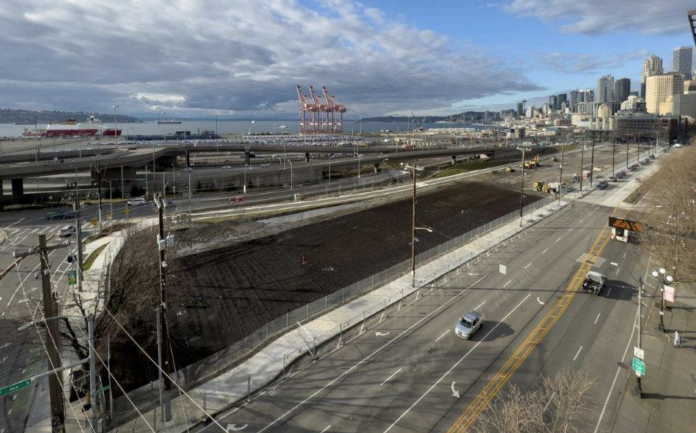
Work is finally getting underway to transform a long-underutilized swath of public land near Seattle’s sports stadiums, but the coming arrival of World Cup games to Seattle in 2026 is set to delay any final vision that gets created. The site in question is nearly five acres, across from Lumen Field on First Avenue S, and is owned by the Washington State Department of Transportation (WSDOT). The former home to WOSCA Terminals, WSDOT purchased the site over ten years ago as part of the Alaskan Way Viaduct Replacement program, and ultimately envisions a partial use for the site as the headquarters for its Washington State Ferries division.
The site’s redevelopment could come with much more than just new state offices, and looks to be seen by the Harrell administration as a key element of its newly announced redevelopment plans for South Downtown, rolled out by the Mayor during his annual State of the City address this week. While not mentioned specifically by name, the proposed WOSCA site redevelopment provides a snapshot into the Mayor’s broader vision for the area.
Through C40 Cities, which bills itself as a “global network of mayors of the world’s leading cities that are united in action to confront the climate crisis,” WSDOT and the City of Seattle are soliciting proposals from the private sector for what will become of the WOSCA site. The project is Seattle’s contribution to the fourth iteration of C40’s Reinventing Cities program, which seeks to “transform underutilized urban sites into innovative, zero-carbon and resilient urban projects.” Seattle has been a member city of C40 since 2006, but has lagged behind other member cities like Paris, Copenhagen, or Bogotá when it comes to transformative projects intended to meet the climate crisis.
But before a permanent development on the site, the City of Seattle envisions a temporary use, planned in the lead up to the World Cup.
“A first phase for the site is a temporary installation that achieves some combination of community gathering, event support, education, sustainability, arts/culture, and civic/regional/State pride — to occur on the site for the next 2-3 years up to and including the summer of 2026 concurrent with FIFA World Cup games,” the C40 call for projects states. “This short-term goal recognizes it would be unlikely for construction of permanent uses to be complete by summer of 2026, and therefore a temporary installation that avoids disruptive construction during the summer of 2026 is advisable.”
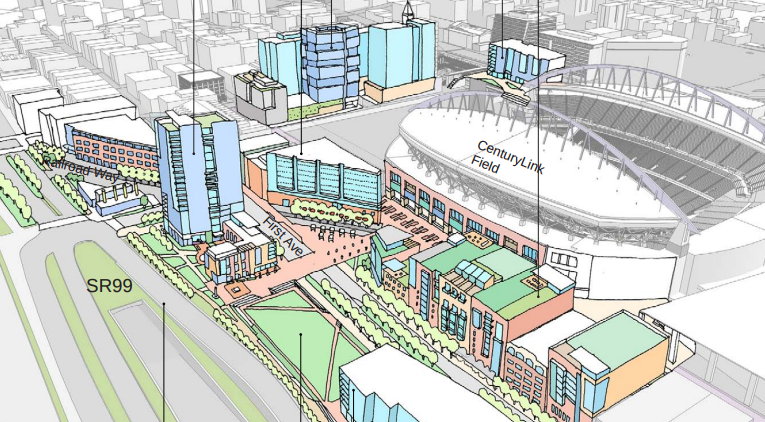
The WOSCA site has been eyed as a “catalyst” site for the area around Seattle’s sports stadiums for more than a decade, with a stadium district study completed in 2013 under Mayor Mike McGinn identifying the potential public benefits that could come from utilizing the site, including public open space, added retail spaces and commercial activation, and some housing, on the north end of the site. That study also identified public parking as a priority for the stadium area, a recommendation that is fairly outdated now — although a waterfront streetcar extending from the still unfinished First Avenue line was also floated.
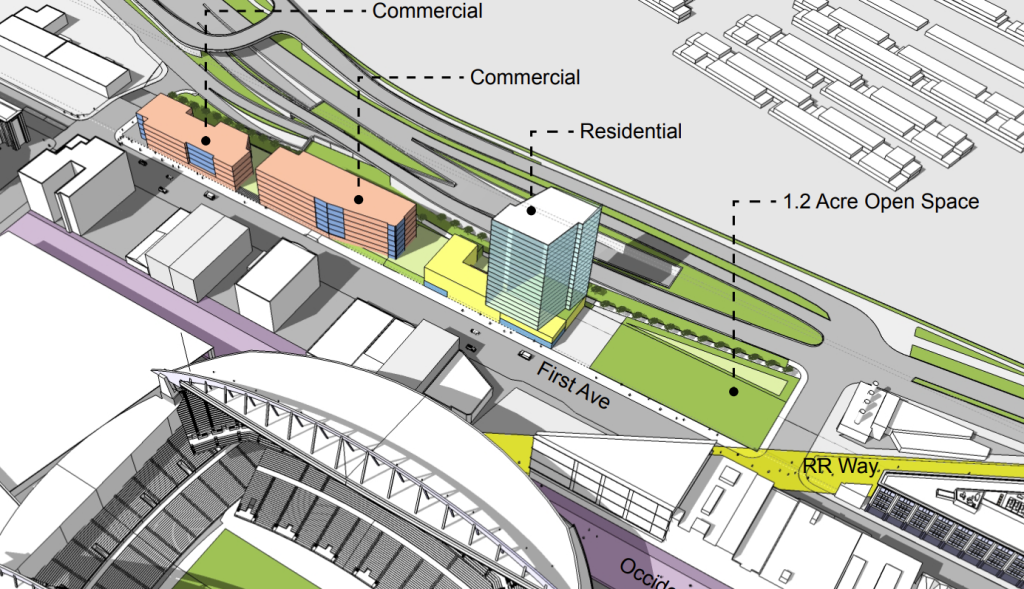
As for what comes after the temporary uses planned for the World Cup? That will depend on what proposals the city and state receive. “Seattle and WSDOT invite creative ideas for private development that would be located on site in addition to the Washington State Ferries headquarters facility,” the call for proposals notes. That call notes that the city’s priorities for the site include downtown recovery, connecting with waterfront improvements to the north, maritime training and skills development, economic development in coordination with the Port of Seattle, event-related gathering, and neighborhood vibrancy.
Unlike what was envisioned in 2013, however, new residential uses on the site aren’t likely. It was advocacy, including a significant amount directly from the Port of Seattle, that kept the city from moving forward with the idea of adding housing capacity in and around the stadium district as part of the City’s maritime and industrial land use strategy, adopted last year after decades of debate.
That being said, nothing is technically off the table at this point. “The site is currently in the city’s Maritime Manufacturing and Logistics (MML) zone, which prioritizes industrial uses,” the calls for submittals notes. “However, the City intends to adopt an agreed upon master plan that is a result of the Reinventing Cities process as the governing land use regulation for the site. Therefore, submitting teams are not limited to the considerations of the existing zoning.”
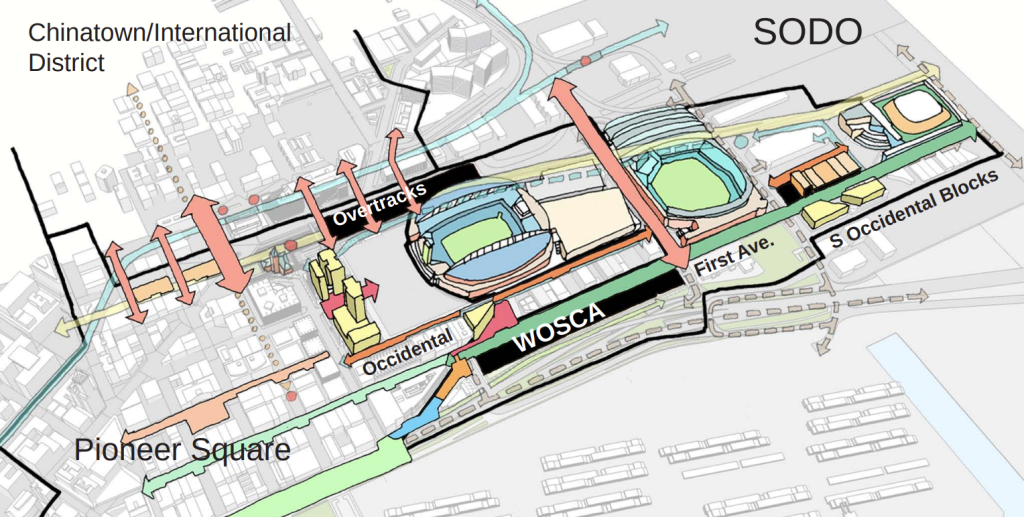
Industrial advocates have long argued that additional housing in SoDo will create pressure against existing industrial uses, including likely demands for changes to the neighborhood’s streets, which heavily prioritize motor vehicle throughput, creating some of the most dangerous corridors in the city. But a high-profile project with residential uses as a core component, a one-off with the WOSCA site, might be able to overcome opposition from freight interests.
“C40 offers an incredible opportunity to bring together innovative and creative minds from around the world to leverage and re-imagine dormant property in the heart of Seattle,” WSDOT Secretary Roger Millar told C40 Cities. “It’s fitting that a parcel of WSDOT-owned land will now be part of a global collaborative process to re-imagine this space for multiple uses. WSDOT looks forward to working with all of the partners and neighbors we serve in the Seattle area to best leverage this opportunity for an outcome that best serves us all.”
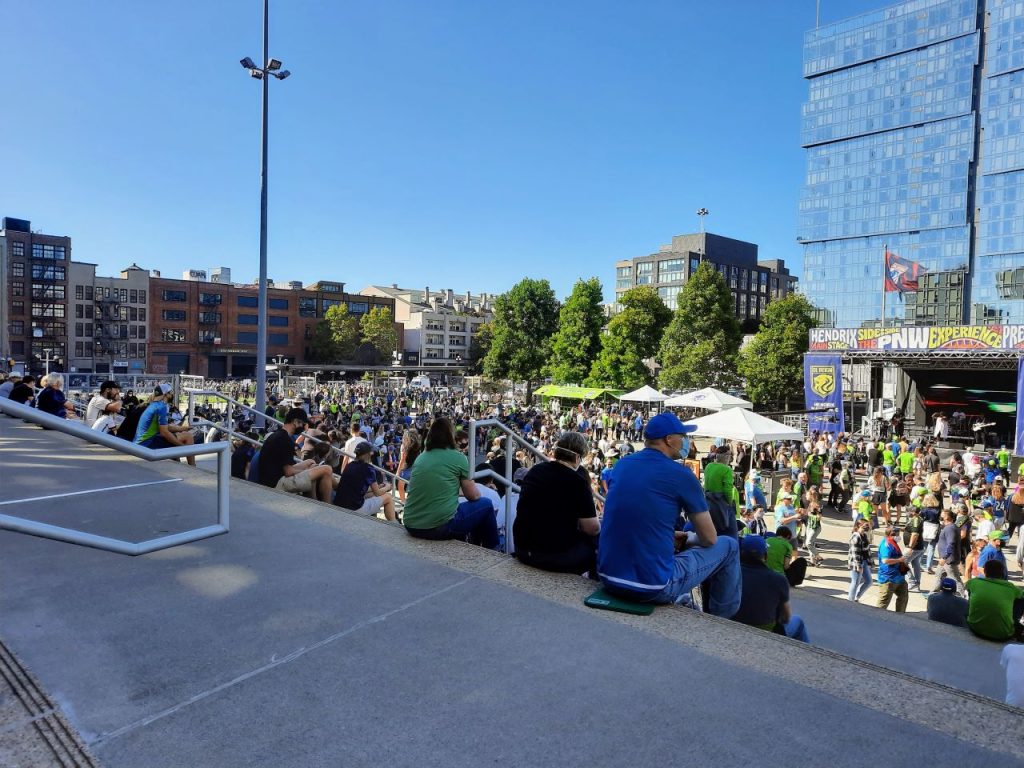
The public-private partnership will likely mirror redevelopments that the City of Seattle has undertaken on the other side of downtown, at Seattle Center, with the redevelopment of Key Arena into Climate Pledge Arena, work that’s on the verge of being replicated at Memorial Stadium with some of the same partners.
Other projects around the country from C40’s Reinventing Cities program’s past phases include Civic Center in San Francisco, a new eight-story affordable housing development next to the city’s city hall, with 112 units of housing dedicated to people with disabilities, and the Downtown Loop Site in Chicago, the site of a former parking garage next to a public park being replaced with a 12-story building with 114 affordable units along with a restaurant and a clinic. Seattle’s project has the potential to actually be much bolder and more transformative than those projects.
Firms interested in partnering on the project will have until mid-September to submit their proposals.
Ryan Packer has been writing for The Urbanist since 2015, and currently reports full-time as Contributing Editor. Their beats are transportation, land use, public space, traffic safety, and obscure community meetings. Packer has also reported for other regional outlets including Capitol Hill Seattle, BikePortland, Seattle Met, and PubliCola. They live in the Capitol Hill neighborhood of Seattle.


